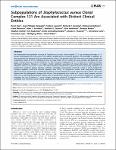Subpopulations of Staphylococcus aureus Clonal Complex 121 Are Associated with Distinct Clinical Entities
Kurt, Kevin
Rasigade, Jean-Philippe
Laurent, Frederic
Goering, Richard V.
Zemličková, Helena
Machova, Ivana
Struelens, Marc J.
Zautner, Andreas E.
Holtfreter, Silva
Bröker, Barbara
Ritchie, Stephen
Reaksmey, Sin
Limmathurotsakul, Direk
Peacock, Sharon J.
Cuny, Christiane
Layer, Franziska
Witte, Wolfgang
Nübel, Ulrich
We investigated the population structure of Staphylococcus aureus clonal complex CC121 by mutation discovery at 115 genetic housekeeping loci from each of 154 isolates, sampled on five continents between 1953 and 2009. In addition, we pyro-sequenced the genomes from ten representative isolates. The genome-wide SNPs that were ascertained revealed the evolutionary history of CC121, indicating at least six major clades (A to F) within the clonal complex and dating its most recent common ancestor to the pre-antibiotic era. The toxin gene complement of CC121 isolates was correlated with their SNP-based phylogeny. Moreover, we found a highly significant association of clinical phenotypes with phylogenetic affiliations, which is unusual for S. aureus. All isolates evidently sampled from superficial infections (including staphylococcal scalded skin syndrome, bullous impetigo, exfoliative dermatitis, conjunctivitis) clustered in clade F, which included the European epidemic fusidic-acid resistant impetigo clone (EEFIC). In comparison, isolates from deep-seated infections (abscess, furuncle, pyomyositis, necrotizing pneumonia) were disseminated in several clades, but not in clade F. Our results demonstrate that phylogenetic lineages with distinct clinical properties exist within an S. aureus clonal complex, and that SNPs serve as powerful discriminatory markers, able to identify these lineages. All CC121 genomes harboured a 41-kilobase prophage that was dissimilar to S. aureus phages sequenced previously. Community-associated MRSA and MSSA from Cambodia were extremely closely related, suggesting this MRSA arose in the region.
Dateien zu dieser Publikation
Keine Lizenzangabe

